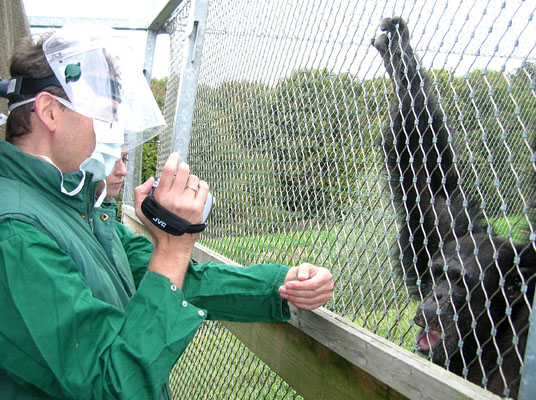As our closest relatives, chimpanzees have played a role in science for nearly 80 years. Because they can contract infections like HIV and hepatitis, they have been valuable for biomedical research. But that research has revealed another trait chimpanzees share with humans: vulnerability to psychological damage. The European Union banned the use of great apes in research in 2010. In January 2013, a U.S. National Institutes of Health report recommended that all but 50 of the nearly 700 chimps in NIH-supported labs be retired to sanctuaries.
Martin Brüne has seen this damage firsthand. A psychiatrist at the University Bochum Hospital in Germany, Brüne specializes in detecting early signs of psychosis in humans. He has always been interested in the mental similarities between chimps and humans, but his research took an unusual turn seven years ago, when a primatologist in Austria asked him to observe a group of ex-laboratory chimps. Brüne noticed behaviors akin to depression, anxiety disorder and post-traumatic stress disorder, though he and his colleagues still wrestle with whether to apply these clinical terms to non-humans. He now works with a group of ten chimpanzees in a sanctuary called AAP in the Netherlands, led by biologist Godelieve Kranendonk. The treatment plan includes prescribing antidepressants.
Brüne shared early results of this treatment at the February 2013 meeting of the American Association for the Advancement of Science in Boston. Afterward, SciCom’s Kelly Servick asked about his work with these extraordinary patients.
What was your impression when you first saw the chimps in the sanctuary?
Even as a non-primatologist, I immediately could recognize that their behaviors were grossly abnormal. Some of the animals engaged in self-mutilating behaviors like scratching wounds and keeping them open, and others showed stereotypic movements like constant body rocking. Others smeared their feces everywhere and engaged in coprophagy [eating their feces]. Such behaviors have never been observed in wild populations, so we can be quite sure to assume that these are abnormal behaviors.
Where had those chimps been before?
Most of the chimps were at a facility for biomedical research in the Netherlands, and many of them are infected with HIV and hepatitis virus. You can retire them in the sanctuary, but you cannot integrate them in other groups because of the infections.
Did you approach the apes as a psychiatrist and apply your practice in a similar way?
Well… no, I wouldn’t say that. They are behind a fence, and it’s dangerous to come too close. You can’t predict their behavior. Still, I think when you look into their eyes, there is something coming back. I had the impression that they have a personality, and there was something behind their look.
Can you trace certain behaviors to certain conditions in the lab?
There are a couple of more common causes of behavioral abnormalities, such as social deprivation, stressful experiences like regular darting to anaesthetize the animals, or early separation from mothers and peers. But it’s very hard to tell, because the individual history of many animals is not known in its entirety.
Why do you think that the initial conditions were so inappropriate? Were they necessary?
That’s a question I am unable to answer. Was biomedical research necessary in great apes? I actually don’t know for sure. Maybe to this extent, it wasn’t necessary. But I also don’t want to accuse anybody for this, because perhaps some 30 years ago, most people didn’t know that these animals are so vulnerable to developing abnormal behaviors and psychopathology.
Is it appropriate to call this “mental illness?”
It’s a very good question. I think we don’t have a better language than [what] we also use for human pathology. We can safely say, I think, that they suffer from depression and post-traumatic stress disorder, based on the common causes of these disorders in apes and humans, and based on the observation of the behavioral signs.
"When you look into their eyes, there is something coming back. I had the impression that they have a personality, and there was something behind their look."
Is there any kind of standard system for diagnosing apes, like the DSM for humans?
No, this doesn’t exist.
Should it?
Well, it should. But I think it would be very difficult to come to this point. Even if you can improve the conditions of the chimps, they still have these abnormal environments. So you cannot expect that they come back to an entirely normal behavioral repertoire. The baseline actually is the behavior in the wild, and any deviation from behaviors observed in the wild perhaps can be classified as abnormal.
You wrote a letter in 2004 to Science [subscription required] suggesting psychiatric treatment for lab chimps. What prompted you to do that?
The concept was discussed during a coffee break at a conference where I met Professor [William] McGrew, who is a well-known primatologist. We were thinking, “Hey, perhaps we can write that for some of the really worst cases, psychiatric treatment could be an appropriate measure.”
And what was the response?
The response was poor, I would say. There was very, very little response to the letter. And so we expanded on these sketchy ideas and wrote a larger review article that was published in Neuroscience & Biobehavioral Reviews. So I think it’s one contribution among many that go in the same direction.
Do you think the scientific community has a different approach now than it did in 2004?
For some reason, I think there is more public attention now, especially with regard to the ethical issues associated with the treatment of chimpanzees in captivity. And that’s a fairly recent development. But it’s good.
Can you tell me about the research in the Netherlands that you’re working on now?
I wouldn’t call it research because it’s not a proper study. What’s going on there is a behavioral observation of chimpanzees who receive behavioral treatment — and some of them medication — in comparison to a control group. But I wouldn’t call it an experiment. It’s more like a naturalistic study.
What medication do they get?
Well, this was my suggestion to use sertraline as a serotonergic drug [one that affects levels of the neurotransmitter serotonin in the brain] for several reasons. In humans, it’s available for treating depression, obsessive-compulsive disorder, binge eating disorder and panic disorder. Because the signs and symptoms observed in the chimps somehow resemble depression, anxiety, and also PTSD, I thought it might be a good idea to start with an SSRI [selective serotonin reuptake inhibitor]. I thought sertraline would perhaps produce the least side effects. And it seems to work very well.
What were the differences between the chimps that got the drugs and those that didn’t?
There were some differences in… behaviors like regurgitation and re-ingestion, and to a lesser degree, body rocking and other stereotypic movements. It seemed to improve social play in these animals, which is very nice to observe.
In the comparison group, abnormal behaviors even increased over time. So it’s very likely that the combination of behavioral treatment and medication had a good effect. But because it was started almost simultaneously, it’s really difficult to disentangle the effect of the diet change, the environmental enrichment, and the medication.
That’s interesting, because if you were going to do a proper study on this, you would try to isolate different treatments.
That’s right, you would control that. But if you have a human patient, you don’t start psychotherapy first, and then if it doesn’t work, pull in medication later. It’s more a very practical approach.
Is this a treatment you would suggest for hundreds of other chimps dealing with similar issues?
No. Some individuals with similar histories or a similar background are more resilient and do not develop abnormalities to such an extent. So I think you always have to take into account individual differences in vulnerability. With regard to the 500 or so chimpanzees in captivity, the decision whether to give them medication has to be made individually.
You mentioned in your 2006 paper that apes might help us understand human mental illness. Can you talk a little bit about what apes have contributed to your field?
Difficult, difficult question. It seems to corroborate findings [in humans] suggesting that the combination of early traumatization and adverse experiences throughout the life span produce psychopathological syndromes.
Also, I find it interesting to see that relatively simple interventions like dietary change and environmental enrichment plus medication produce such profound improvements. My guess is this wouldn’t be the case in a human who grew up under similar circumstances. So the amazing conclusion could be that we as humans are still more vulnerable to adversity than even chimps are.
Why might that be?
It could be that when the human lineage split from the chimpanzee lineage, there were some genes selected in ourselves that made us more flexible behaviorally. We can certainly adapt to a greater range of environmental circumstances than chimpanzees can. That’s why we populated the globe and not chimps. But on the other hand, this could perhaps come at a cost. And the cost is perhaps increased susceptibility to psychological disturbances.
What do you think is going to happen to all the currently captive chimps?
Hopefully they will be retired to good sanctuaries, and in case they have pervasive behavioral problems, they should receive proper treatment. But because they can become 50 or perhaps even 60 years old, I think the problem will be around for at least another couple of decades.
What’s the next step for this project in the Netherlands?
The next step is to put others on medication — those that were in the comparison group — and see if it works as well as in the first intervention group. Maybe it’s a model for other sanctuaries, but this is something I don’t know.
Do you hope to influence the way that chimps are cared for in general?
I’m skeptical. It’s my hope, of course, but in light of the reservation people have about medication in general, and perhaps more specifically treatment of non-human primates, I have my doubts that it has much influence. But who knows?
Do any individual apes stand out in your mind as particularly interesting cases?
I remember one chimpanzee who… was held in captivity in a garage by a private person. And he was in a cage that was two by two by two meters. He was fed human food — fast food and so forth. And when he came to the sanctuary, he was really, really a big person, overweight.
He wasn’t a real chimp anymore. He tried to walk on two legs — he didn’t know how to walk like a chimpanzee. He always wanted a straw to drink from bottles. That was really a terrible observation. But he received some medication temporarily, and he’s a lot better now.
____________________
Kelly Servick, a graduate student in the Science Communication Program at UC Santa Cruz, earned her bachelor's degree in cognitive science and comparative literature at the University of Georgia. At UCSC, she has worked as a reporting intern at the Stanford University School of Engineering, the Santa Cruz Sentinel, and KUSP public radio. This summer and fall, she'll work as a science-writing intern at Science in Washington, D.C.
© 2013 Kelly Servick


